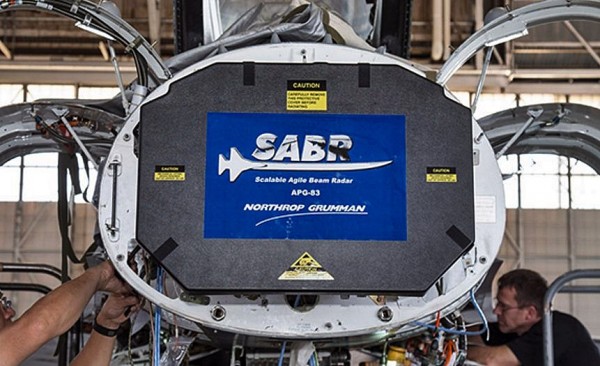New AESA Radar Makes Old US F-16s Better than New Russian Su-35S in Dogfighting
| Arthur Dominic Villasanta | | Jun 08, 2017 10:09 PM EDT |
(Photo : Northrop Grumman) SABR AESA radar on an F-16.
The selection by the U.S. Air Force of the APG-83 Scalable Agile Beam Radar (SABR), an advanced active electronically scanned array (AESA) system, to upgrade the General Dynamics F-16 Fighting Falcon makes this legacy fighter more formidable in air-to-air combat than the newer Sukhoi Su-35S of the Russian Air Force.
Like Us on Facebook
The F-16 entered service with the air force in 1978 while the Su-35S was introduced into service only in 2014. More than 4,500 F-16s of various models have been produced, and the newer mods remain in front line service.
The addition of the APG-83 greatly increases the F-16's capabilities against increasingly sophisticated threats that include the Su-35S Flanker-E and new Russian cruise missiles. Only some 60 Su-35Ss have been built so far.
Compared to the F-16's existing APG-68 mechanically scanned radar, the APG-83 can detect, track and identify a larger number of targets much faster and at much longer ranges. APG-83 also has much higher resolution than the current radar.
The radar upgrade extends the operational viability and reliability of the F-16 and provides pilots with 5th generation fighter radar capabilities to counter and defeat Russian fighters.
The greater bandwidth, speed, and agility of the APG-83 allow F-16s operate in hostile electronic environments. The AESA radar features all-weather, high-resolution synthetic aperture radar mapping, which presents the pilot with a large surface image enabling precision target identification and strike.
The new APG-83 is also the standard radar for Lockheed Martin's new Block 70 F-16, which the company hopes to export to India and others. Ultimately, the APG-83 will become the standard radar for most of the F-16 fleets around the world.
Northrop Grumman will upgrade 72 U.S. Air National Guard F-16s with the APG-83 to meet a U.S. Northern Command Joint Emergent Operational Need for homeland defense.
"AESA radar upgrades are critically important to give the F-16 community, the tactical advantage it deserves, and we are honored to provide this differentiating technology for the safety and mission effectiveness of our warfighters," said Bob Gough, vice president, combat avionics systems, Northrop Grumman.
"The APG-83 SABR system is in full rate production and available now for U.S. and international F-16 upgrades."
In contrast, the Su-35S operates the inferior PESA (Passive Electronically Scanned Array) radar that can track fewer aerial targets at shorter ranges.
AESA is a more advanced, sophisticated version of the original PESA phased array technology. PESAs can only emit a single beam of radio waves at a single frequency at a time.
On the other hand, AESA can radiate multiple beams of radio waves at multiple frequencies simultaneously. AESA radars can spread their signal emissions across a wider range of frequencies, which makes them more difficult to detect over background noise. This allows ships and aircraft to radiate powerful radar signals while still remaining stealthy.
Most of the radar systems used in modern combat aircraft are AESA systems. The Su-35S is a notable exception to this rule.
Russia has no plans of deploying an AESA system on the Su-35S any time soon.
TagsU.S. Air Force, APG-83 Scalable Agile Beam Radar (SABR), Active Electronically Scanned Array, AESA, General Dynamics F-16 Fighting Falcon, Sukhoi Su-35S, Russian Air Force, PESA, Passive Electronically Scanned Array
©2015 Chinatopix All rights reserved. Do not reproduce without permission
EDITOR'S PICKS
-

Did the Trump administration just announce plans for a trade war with ‘hostile’ China and Russia?
-

US Senate passes Taiwan travel bill slammed by China
-

As Yan Sihong’s family grieves, here are other Chinese students who went missing abroad. Some have never been found
-

Beijing blasts Western critics who ‘smear China’ with the term sharp power
-

China Envoy Seeks to Defuse Tensions With U.S. as a Trade War Brews
-

Singapore's Deputy PM Provides Bitcoin Vote of Confidence Amid China's Blanket Bans
-

China warns investors over risks in overseas virtual currency trading
-

Chinese government most trustworthy: survey
-

Kashima Antlers On Course For Back-To-Back Titles
MOST POPULAR
LATEST NEWS
Zhou Yongkang: China's Former Security Chief Sentenced to Life in Prison

China's former Chief of the Ministry of Public Security, Zhou Yongkang, has been given a life sentence after he was found guilty of abusing his office, bribery and deliberately ... Full Article
TRENDING STORY

China Pork Prices Expected to Stabilize As The Supplies Recover

Elephone P9000 Smartphone is now on Sale on Amazon India

There's a Big Chance Cliffhangers Won't Still Be Resolved When Grey's Anatomy Season 13 Returns

Supreme Court Ruled on Samsung vs Apple Dispute for Patent Infringement

Microsoft Surface Pro 5 Rumors and Release Date: What is the Latest?












